Boost your organizational outcomes with smart skilling and staffing solutions
Can the workforce dilemma be solved?
The staffing shortage in the healthcare industry is nothing new. It has been gradually ongoing for the past years. And it is rather getting worse. The World Health Organization predicts a shortfall of 15 million health workers by 2030, mostly in low- and lower-middle income countries. However, countries at all levels of socioeconomic development face, to varying degrees, difficulties in the education, employment, deployment, retention, and performance of their workforce.1
Our estimate is that rural areas will be particularly effected. Highly skilled staff are more likely to look for employment in urban areas, with clinical institutions in rural areas facing challenges to offer the complete clinical portfolio and high-quality care.
In addition, medical technology and clinical procedures are becoming increasingly more complex. This challenges healthcare institutions to do more with fewer resources to secure continuous operations or sustain their expansion plans.
We as Siemens Healthineers see a growing staffing market meant to fulfill the need for clinical staff. Current staffing suppliers, however, merely serve as headhunters – hiring from an existing market, managing the staff, and outsourcing it back to the market at higher rates, without improving workforce capabilities.
Can this dilemma be solved? With our workforce solutions, we are supporting healthcare institutions to successfully manage the challenges they are facing.
Workforce challenges include
- Limited staff with limited skills and competencies
- Changing roles, tasks, and expectations on work-life balance
- Workload impacting staff retention and satisfaction
- Evolving technologies requiring new skills
Operational challenges include
- Decreased performance and outcomes
- Significantly less revenue
- Missed KPI from financial and operation point of view
- Lower patient satisfaction due to slow operations
The clinical staffing market is changing
Whether public or private, health systems all around the globe have the same tasks: to prevent diseases and care for patients. While these tasks are delivered differently in every country, the success of each health system relies on a robust workforce, optimized processes, as well as the right technologies. If one is out of balance, the construct might eventually collapse.
The world had a global shortfall of at least 43 million health care workers in 2019 – before the pandemic even started.2 Staffing shortage affects multiple levels within a clinical institution, and trends indicate that the shortage could worsen.
In the United States alone, 32% of registered nurses surveyed in November 2021 said they may leave their current direct-patient-care role – an increase of 10% in under ten months.3 Radiology is experiencing shortages across various positions and modalities and is struggling to both maintain staffing levels and bring in new talent.4
Reasons for workforce shortage
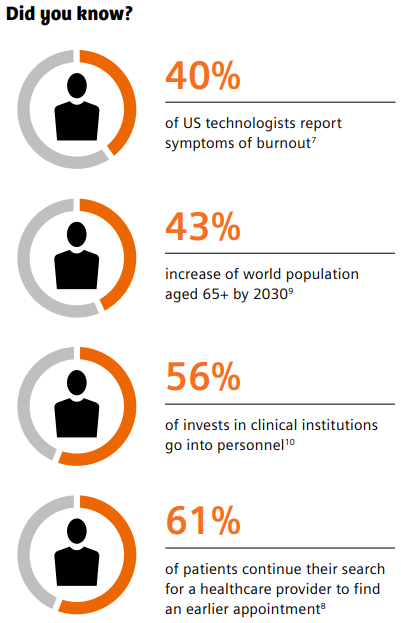
There are many reasons why fewer and fewer people want to work in the healthcare sector. Let’s look at some trends that cause the numbers of radiologists and radiographers to decrease.
Retirement
The aging workforce is expected to leave a significant gap between demand for and supply of radiologists by 20255
Burnout
Radiologists rank among the highest for burnout, as the general demand for imaging far outpaces staffing increases5
Trainee positions
From 2010 to 2020, the number of diagnostic radiology trainees entering the workforce increased just 2.5% compared to a 34% increase in the number of adults over 656
Assemble
portfolio Encouraging radiologists to practice in more rural areas is a challenge in countries across the globe6
Impact of staffing shortage
A shortage of radiologists, radiographers, and nurses has direct and indirect impacts on clinical operations and patient care – reaching from exam backlogs, delayed exam results, delayed patient treatment, and having no time to provide high-quality patient care.
Less turnover
When a technologist is missing, clinical institutions cover the procedures with their remaining staff, postpone procedures, or lose them entirely. These actions result in direct costs like overtime payments and loss of revenue as well as in implicit costs like negative morale impacts on the remaining staff. This can ultimately lead to a poor patient experience.
Higher staffing costs
Finding and training staff is costly. In the USA, hiring an entry-level employee is estimated to cost about 20% of that employee’s salary, while hiring a mid-level employee typically runs up an average cost of $60,000, or 1 to 1.5 times the employee’s salary.11 Factors that can impact the costs of recruiting, hiring, and onboarding a new employee include the HR team, external recruiters, job posting, candidate screening, background checks, compensation, training, corporate equipment and credentials.12
Loss of productivity
According to business expert Josh Bersin of Deloitte, a new employee can take up to 2 full years to reach the same level of productivity as an existing staff member.13
Loss of reputation
Unsatisfied employees can lead to an increased staff turnover. This can have negative impacts on the overall reputation of a clinical institution. First, it will be harder to find new talent because word will spread that this is no good workplace. And second, delivering high-quality care will become challenging with understaffed teams.
Loss of competency
There are two ways how a clinical institution can lose competency. One is highly skilled staff leaving the institutions. And the other is not offering continuous education to the present teams.
Inefficient treatment
As radiology departments are of great financial and clinical importance to hospitals, inefficient treatment processes and treatment errors directly impact downstream treatment and increases cost of treatment. Errors in examination procedures lead to14
- rescans
- longer waiting times
- lost revenue
- improper or delayed treatment
- patient dissatisfaction
In short: Staff shortage coupled with inadequately educated staff leads to higher costs, inefficient workflows, lower patient throughput, less revenue, lower quality of care, reduced employee satisfaction and performance – and can negatively affecting patient satisfaction and the clinical institution’s reputation.15 Healthcare providers require robust strategies to optimally attract, train, and retain talent on their own or with a reliable partner. Failing to do so, will result in tighter financial operation that can compromise the institution sustainability

How can staffing and skills gaps be closed?
There are some solutions that can help healthcare providers close the staffing gap in their radiology department and enhance staff satisfaction.
Teleradiology
Teleradiology can help compensate staff shortage because radiologists don’t have to be physically present at a clinical institution. This solution is especially interesting for rural hospitals that have difficulties attracting radiologists. With teleradiology, they can send their cases to experienced radiologists and offer their patients high-quality care.
But teleradiology also has benefits for radiologists. It allows them, for example, to move to the country and combine a better quality of life with a workflow that compliments their lifestyle. Also, using teleradiology enables radiologists to collaborate with other remote radiologists and physicians, creating multidisciplinary teams to provide professional and emotional support for each other.16
Artificial intelligence (AI)
AI is a solution that can make the radiology workflow more efficient. Computer-aided detection (CAD) represents the earliest clinical applications of basic AI in radiology. CAD systems have been progressively implemented in radiological practice in the last two decades in the detection of lung, colon, breast, and prostate cancer. Automated segmentation is crucial as an AI application for reducing the burden on radiology workflow of the need to perform segmentation manually.17
With the Digital Twin, AI is also likely to play a key role in personalized care. Research by scientists from the Weizmann Institute of Science in Rehovot in Israel showed that based on huge volumes of data, AI could identify patterns and estimate how study participants would respond to a given type of food. In the future, the aim is for Digital Twins to act as an individual representation of a specific patient in the healthcare system, used to predict the effects of a lifestyle change, drug, or treatment option on each individual.18
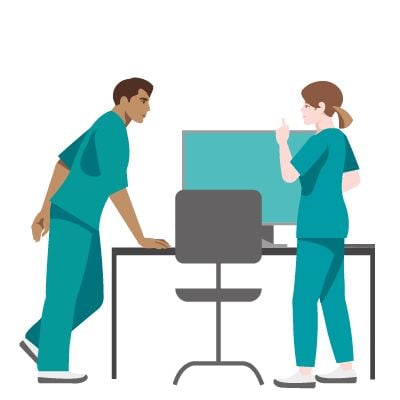
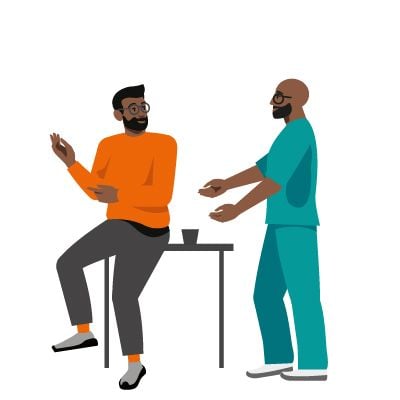
Education and learning
In the healthcare sector, lifelong learning is essential to keep up with new technologies and techniques. Efficiently onboarding new staff members is also key. But employees also need the time to learn. They should be able to block time for learning. There’s even talk about a 4+1 workweek – with 4 days of work and 1 day of learning.
According to Forbes, there’s a general demand for flexible work as well as an appetite for learning, growth, and development as a top priority among employees, and a fast-growing need for constant upskilling and reskilling will lead most employers to a 4+1 workweek. More than 9-out-of-10 employees desire a 4-day workweek, but only 6% of senior leaders say they are currently offering or planning to offer it.19
Temporary and contingent staff
Hiring temporary onsite staff can help to quickly close staffing gaps for radiologists and radiographers. They work onsite as part of your team and can be flexibly booked for a defined time period. This allows clinical institutions to easily cover sick leaves, vacations, high workloads, or a staff shortage.
Temporary radiologists and radiographers are usually highly skilled, trained, and experienced. In the best case, they can even share their knowledge and competency with the clinical staff.
Attracting students
To attract radiology students, universities should provide a more flexible and innovative learning offering. Adding immersive and engaging technologies such as Virtual Reality (VR) and simulation software to the mix with onsite learning can help students gain hands-on experience with technology and techniques in a safe environment where making mistakes does not harm patients. In addition, VR and simulations also add a fun factor to learning, which is also important.
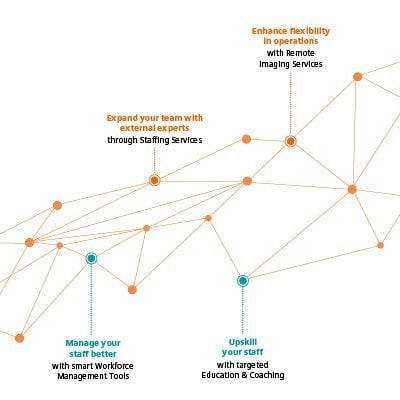
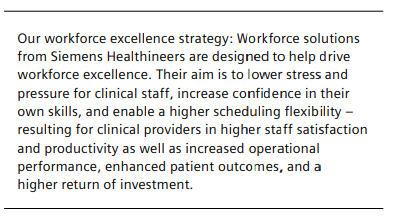
01 ı Workforce Management Tools
Smart Workforce Management Tools help to fill the different shifts in clinical institutions as well as to manage the clinical workforce with more intelligence and flexibility.
Education management with PEPconnections: With workforce education management and administration features, employers can help continue advancement of their staff. PEPconnections* is a PEPconnect premium subscription where education managers can personalize the education experience of individual employees with customizable learning plans, combining education designed by Siemens Healthineers and/or your institution. Assign, create, track, and manage the education of entire groups – all easily accessible in one solution.
Help ensure no shift goes unfilled with CrewPlace™ Enterprise: CrewPlace Enterprise is a web and mobile application that allows healthcare organizations to visualize their real-time staffing positions, deploy a range of options to help ensure no shift goes unfilled, and leverage Siemens Healthineers extensive training options to prepare staff members for even the most advanced procedure tasks. This comprehensive solution helps clinical departments manage a range of staffing solutions including staff profiles, time-off requests, shift requests and swaps, as well as staffing gaps.
02 ı Education & Coaching
With customized upskilling, clinical institutions can expand their clinical staff’s expertise, competencies, and confidence.
Onsite and remote coaching with our application experts: Application experts from Siemens Healthineers train clinical staff either onsite or remotely. The online training can be performed in a virtual classroom or as an individual training session. Remote Trainer, for example, is a personalized service where experts from Siemens Healthineers interact with clinical staff remotely via the secure Smart Remote Services (SRS)** connection to train them on equipment and clinical applications from Siemens Healthineers – using audio, video, and chat functions. With Remote Trainer, individual remote training courses are scheduled in shorter sessions that are convenient to each learner, thereby making equipment and staff available to maintain daily operations during peak patient times.
Hybrid learning for customized learning: Hybrid learning solutions from Siemens Healthineers offer clinical staff a variety of education formats to improve their competences and learning experiences – anytime and anywhere. Hybrid learning is an evolutionary approach to application and equipment training that goes beyond equipment usage. Our hybrid learning solutions impart both knowledge and competence with a mix of personal, remote, and virtual learning formats.
Online learning experience with PEPconnect:
PEPconnect is our personalized online education experience designed for healthcare professionals. This can be helpful, for example when training basic knowledge of technology before onsite training. The education is easily accessible, anywhere, anytime, on any device, and can include e-learnings, webinars, job aids, virtual classroom, and more. Customers can also benefit from the online network of professionals and connect, communicate, and be part of social learning groups. Beyond the 19,000 learning activities available, Advanced Digital Education Subscriptions expand on the essentials in our base offerings with options including PEPconnections*, Advanced Clinical Content, and Virtual Wallet Points.
Digital and immersive education: Immersive technologies like Augmented Reality, Virtual Reality, or simulated environments provide a hands-on approach in a safe environment for practical skills development. SmartSimulator, for example, lets clinical staff train and practice on a virtual medical device from Siemens Healthineers – helping them enhance confidence without blocking real systems for training and education. ExpertGuidance is a mobile Augmented Reality training application designed to increase operational efficiency and decrease the time to proficiency regarding equipment onboarding and clinical workflows – by allowing staff to train complex procedures and workflows in a safe, virtual environment. AR/VR Partner solutions are easily accessible, holistic education for various clinical fields that goes beyond equipment usage – from instrumentation and procedure training for OR staff to gaming simulations for quick and correct reactions in different emergency situations.
03 ı Staffing Services
Clinical providers struggling to fill workforce gaps can book additional services that bring qualified experts onsite.
On-demand technologists with FlexForce Tech: FlexForce Tech is a workforce solution that provides highly skilled radiographers with OEM training and support. These radiographers have in-depth knowledge of equipment and applications as well as soft skills to integrate seamlessly into your organization and operate equipment from Siemens Healthineers efficiently. This service helps reduce staff shortages while increasing the total number of procedures performed and leading to improved outcomes.
On-demand education experts with FlexForce Coach: FlexForce Coach is a comprehensive staff development and performance consulting solution provided by experts from Siemens Healthineers. It drives change management in clinical departments and enables standardization of equipment protocols across multiple shifts and locations. A FlexForce Coach also provides equipment and applications training to radiographers, improving the quality and efficiency of work of an entire department.
04 ı Remote Imaging Services*
Clinical institutions that need scans performed or images interpreted can book remote services that allow flexible operations and optimized productivity.
Remote scanning with WeScan: WeScan** Remote Scanning provides flexible access to the expert knowledge of our remote MRI technologists, especially during extended hours, off-hours, and peak hours, which are usually difficult to staff. This enables you to achieve continuous productivity and higher flexibility in patient care – regardless of your individual staffing situation.
Remote scanning assistance with syngo Virtual Cockpit: syngo Virtual Cockpit*** is Siemens Healthineers’ vendorindependent software for remote scanning assistance. Transform care delivery and achieve a higher level of standardization and diagnostic consistency, by enabling virtual access to internal experts. Support scans at three different devices (CT, MRI, PET, SPECT) simultaneously and provide the highest quality of care in all of your locations, even in structurally weaker regions. Care teams always stay connected through a camera feed, voice-over-IP, and chat functions.
Remote reading with WeRead: WeRead**** is a vendorand modality agnostic platform that can be used to outsource remote reading from healthcare providers to external teleradiologists. WeRead matches radiology demand and supply, manages administrative and financial processes as well as seamless teleradiology workflows.

Summary
Success Stories With the healthcare workforce market changing, decision-makers have to make smart investments in their clinical staff as well as in technology. Without appropriate staffing options, provider capabilities will decrease, and patient outcomes might be directly, negatively impacted. Offering smart education and workforce solutions and leveraging digital innovations, Siemens Healthineers is well set up and positioned to support clinical institutions in solving their staffing gaps and workforce concerns – wherever they are.
 Success Stories
Success Stories
 |
Technicians with a very busy schedule and changing work locations were difficult to reach and bring together to one space to introduce them to product fundamentals. “Through this remote training approach, more participants were able to attend the training. This proved to be highly efficient. We could solve problems at hand quickly. Training time was flexible, which was very important to us.”
|
 |  | |
An increasing number of patients and shortage in qualified personnel required a workforce solution to avoid downtimes. “With WeScan, we can compensate for staff shortages in a targeted manner and therefore can continue to offer our entire spectrum of MRI examinations at our two sites. Especially, in the event of staff changes as this allows for real planning, security and flexibility for our MTRAs and patients.”
Dr. med. Norbert Wilke, | A highly experienced CT technologist had a very serious injury and the shift had to be quickly filled.
“Alex is our FlexForce Technologist, and he has done an awesome job since he’s been here. He is very reliable, he is very skilled, and he has done it with a smile on his face.”
Danielle Coleman, | |
|
|
The results by customers of Siemens Healthineers described herein are based on results that were achieved in the customer’s unique setting. Since there is no “typical” hospital and many variables exist (e.g. hospital size, case mix, level of IT adoption) there can be no guarantee that other customers will achieve the same results.
 |  | |
Teachers have to cater the different learning needs of students. “The future of medical education is changing now and will continue to change. We’ll see more virtual reality; the virtual space being used.”
Prof. Louise Rainford, | Changes in restrictions required changes in radiology stafftraining for the CT system. “The result of the online training was of real benefit to the hospital because before, we had four technicians who knew how to do the exams using the tomograph. After the training, we had a specialized tomography team of 13 people.”
Raquel Cristina Selister, | |
|
|
The results by customers of Siemens Healthineers described herein are based on results that were achieved in the customer’s unique setting. Since there is no “typical” hospital and many variables exist (e.g. hospital size, case mix, level of IT adoption) there can be no guarantee that other customers will achieve the same results.
 |  | |
The MOBILETT Elara handover training had to be performed fully virtually using PEPconnect assigned training modules and remote sessions with SmartSimulator as follow up. “We have a couple of installations in that remote area, but we have to fly there. If we want to reduce the costs for the customer, I think it is a great alternative if we can offer virtual education options, especially in these cases in which the customer has prior experience with FLC software-based systems.”
Helene Chouinard, | Because the Daegu region was a COVID-19 hotspot, the Application Specialist couldn’t reach the customer site and had to teach the staff remotely how to operate their first new Dual Source CT scanner. “Although it was not easy for the Application Specialist to reach us as a result of the travel restrictions, I had hoped that we would be able to operate the CT scanner as soon as possible because of our experience with the SOMATOM Definition AS+. However it was not easy to create and optimize scan protocols on the newly installed dual source system, SOMATOM Force. By using SmartSimulator and SRS, protocols were created in advance and imported to the scanner, enhancing operations from day 1 already. Real-time monitoring and support for trouble shooting queries was easy when connected via SRS. When using these online solutions, I felt Apps was sitting aside of me.”
Mr. Kim, | |
|
|
References
- https://www.who.int/health-topics/healthworkforce#tab=tab_1 (Skills shortage and demand in MTA professions, German Hospital Institute e.V., Düsseldorf, Germany, 2019)
- https://www.axios.com/2022/05/24/the-health-care-workforceshortage-problem
- https://www.mckinsey.com/industries/healthcare-systems-andservices/our-insights/surveyed-nurses-consider-leaving-directpatient-care-at-elevated-rates
- https://www.appliedradiology.com/articles/times-are-tightstaff-shortages-prompt-new-strategies
- https://www.elsevier.com/clinical-solutions/insights/resources/ insights-articles/clinical-decision-support/radiology-at-acrossroads-brief
- https://www.rsna.org/news/2022/may/Global-RadiologistShortage#:~:text=Specialty%20affected%20by%20 COVID%2D19%2C%20aging%20population%20and%20 demand%20for%20imaging&text=A%20convergence%20 of%20factors%2C%20including,a%20global%20shortage%20 of%20radiologists.
- “Radiology staff in focus research report“, The MarkeTech Group (TMTG)
- “2017 Patient Access Journey Report,” Kyruus
- Census (2016): https://www.census.gov/content/dam/Census/ library/publications/2016/demo/p95-16-1.pdf, 2019, p.3; World Bank:
- https://revcycleintelligence.com/news/hospitals-target-laborcosts-layoffs-to-reduce-healthcare-costs
- https://www.zippia.com/advice/cost-of-hiring-statisticsaverage-cost-per-hire/
- https://www.businessnewsdaily.com/16562-cost-of-hiring-anemployee.html
- https://www.huffpost.com/entry/high-turnover-costs-waymore-than-you-think_b_9197238
- Sheridan, „Radiology: Hospitals’ biggest opportunity needs a quality standard,“ 02 November 2015. [Online]. Available: https://www.beckershospitalreview.com/hospital-physicianrelationships/radiology-hospitals-biggest-opportunity-needs-aquality-standard.html. [Zugriff am 02 11 2017].
- K. K. Dahlgaard, „Kompensation von kurzfristigen Personalausfällen im Pflegebereich,“ Das Krankenhaus, p. 317–324, 2014.
- https://www.rsna.org/news/2020/february/internationalradiology-societies-and-shortage
- https://insightsimaging.springeropen.com/articles/10.1186/ s13244-019-0738-2#:~:text=AI%20can%20be%20used%20 as,%2C%20images%2C%20and%20quantitative%20data.
- https://www.siemens-healthineers.com/perspectives/ humanizing-medtech
- https://www.forbes.com/sites/brandonbusteed/2022/05/15/ why-the-4--1-workweek-is-inevitable/?sh=7e2d33b3f6c5
*Remote Imaging portfolio consists of the remote-scanning-offerings “WeScan” & “syngo Virtual Cockpit”, Expert-I enabled Siemens Healthineers MRI scanner, remote technologist, and the remote-reading offering “WeRead”.
**WeScan is not commercially available in all countries. Due to regulatory reasons its future availability cannot be guaranteed. Preconditions: Connection to Smart Remote Services (SRS) infrastructure is required and Expert-i enabled MRI scanner from Siemens Healthineers with appropriately trained personnel operating under applicable federal, state, and local laws as to the MRI scanner and contrast.
***syngo Virtual Cockpit is not commercially available in all countries. Due to regulatory reasons its future availability cannot be guaranteed. Precondition: Expert-i enabled modality from Siemens Healthineers and appropriately trained personnel operating under applicable federal, state, and local laws as to the specific imaging modality(ies), including radiation and contrast. Use from home: Prerequisite is a secure VPN connection to the department network. Use syngo Virtual Cockpit anywhere/at all locations. Prerequisites include Internet connection to clinical network, DICOM compliance, meeting of minimum hardware requirements, and adherence to local data privacy regulations.
****WeRead is currently under development and commercially only available in Germany as BEFUND24. Please contact your local Siemens Healthineers organization for further details.
























